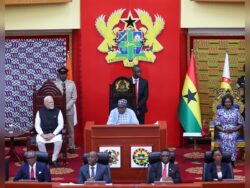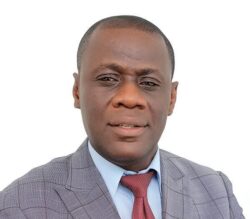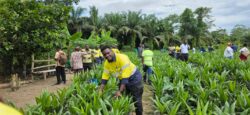By Kestér Kenn KLOMEGÂH
St. Petersburg Economic Forum remains one of the valuable platforms for developing strategic trade ties and forging investment cooperation with potental partners, both local and foreign, within the changing geopolitical rivalry and competition.
Organized by Roscongress Foundation, and held from June 18-21, the forum attracted more than 20,000 delegates from over 140 countries. India, targeting to establish comprehensive partnerships and in search for more economic opportunities, actively participated in several programmes and corporate events.
In this interview (Q&A), President of Indian Business Alliance (IBA) and Founder of The Imperial Tailoring Co., Sammy Kotwani offers insights into the evolving dynamics of Indian investment prospects and its entrepreneurs’ step-by-step participation in SPIEF-2025. Here are the interview excerpts:
How would you assess, in some details, Indian entrepreneurs and state officials’ participation in SPIEF-2025?
Sammy Kotwani: India’s presence at SPIEF 2025 was both strategic and highly visible, underscoring the growing complexity and depth of Indo-Russian ties:
- Government Representation: India sent a high-level delegation, including union ministers, senior bureaucrats, and state trade representatives. They took part in bilateral meetings, multilateral BRICS panels, and sector-focused roundtables.
- Business and Entrepreneurial Engagement: Over 80 delegates from India’s private sector—including large corporates, tech innovators, MSMEs, and exporters—actively participated in the SPIEF platform. Their focus was clear: to explore joint ventures, technology collaboration, and direct investment channels.
- B2B Forums and Exhibits: Indian enterprises were prominently featured in curated SPIEF sessions such as “Business Dialogue: Russia–India” and showcased at national pavilions. There was heightened interest in areas like green technology, pharma, logistics, textiles, and software services.
- Institutional Representation: Key trade and investment promotion agencies like FIEO (Federation of Indian Export Organisations), Invest India, and the India–Russia Business Alliance facilitated partnerships and led discussions on reducing trade bottlenecks.
What sectors are the main trends and directions talking about bilateral trade between India and Russia? Has there been any noticeable change with regards to the private sector between the two countries?
SK: India–Russia trade, historically anchored in energy and defence, is seeing noticeable diversification. Key emerging sectors and trends include:
- Energy and Commodities: India remains the top importer of Russian oil in 2025, maintaining an average of 1.9 million barrels per day. Fertilizer imports are also on the rise, supporting India’s agricultural sector.
- Pharmaceuticals and Healthtech: Russian interest in Indian pharma has grown, with SPIEF hosting dialogues on technology transfer, local production under “Make in Russia,” and collaborative R&D ventures.
- Logistics and Infrastructure: Efforts are accelerating to operationalize the Chennai–Vladivostok Maritime Corridor, develop port alliances, and strengthen rail-road linkages to Eurasia via INSTC (International North-South Transport Corridor).
- Technology and AI: Startups and established firms from India in cybersecurity, artificial intelligence, and fintech engaged in strategic talks to co-develop platforms and deploy cross-border solutions, indicating a strong private sector momentum.
- Digital Payments and Banking: Institutions like Sberbank and Indian banks discussed alternative payment systems, rupee–ruble trade settlements, and direct banking linkages in response to Western sanctions.
- Education and Culture: Agreements between universities, cultural exchanges, and Indian education expos in Russia suggest deeper people-to-people cooperation.
Notable Shift: There’s a clear movement from purely government-driven cooperation to private-sector-led innovation and trade, reflecting India’s global entrepreneurial expansion and Russia’s strategic pivot eastward.
From above discussion, what would say about the significance of St. Petersburg Economic Forum (SPIEF), particularly in the context of BRICS, as Russia and India are staunch members, and the level of both India’s and Russia’s relations for South-South cooperation?
SK: SPIEF 2025 served as a powerful reflection of how Russia and India, as two foundational BRICS members, are shaping a multipolar world through mutual engagement:
- Platform for BRICS+ Synergy: The forum embraced themes such as alternative development financing, local currency trade settlements, and technology independence, all key BRICS priorities.
- Championing the Global South: The India–Russia dialogue was framed within a South–South cooperation narrative, emphasizing non-Western development models, fair technology access, and shared growth ambitions across Asia, Africa, and Latin America.
- Strengthening Strategic Autonomy: Both nations signaled strong support for building systems independent of Western infrastructure—financial, digital, and diplomatic—using SPIEF as a showcase for resilience and shared sovereignty.
- People’s Diplomacy: Cultural, academic, and grassroots events held alongside business sessions signaled a growing soft-power partnership, further anchoring the bilateral relationship in shared values and mutual trust.
Conclusion – SPIEF 2025 marked a milestone in Indo-Russian engagement. It reflected a maturing strategic relationship evolving beyond hydrocarbons and military equipment into high-growth sectors like digital trade, healthcare, and infrastructure. The growing role of Indian private enterprise, the diversification of trade, and the alignment with BRICS values of equity and autonomy together reaffirm SPIEF’s significance as a bridge between India and Russia—and a beacon for South–South cooperation in the multipolar world order.










